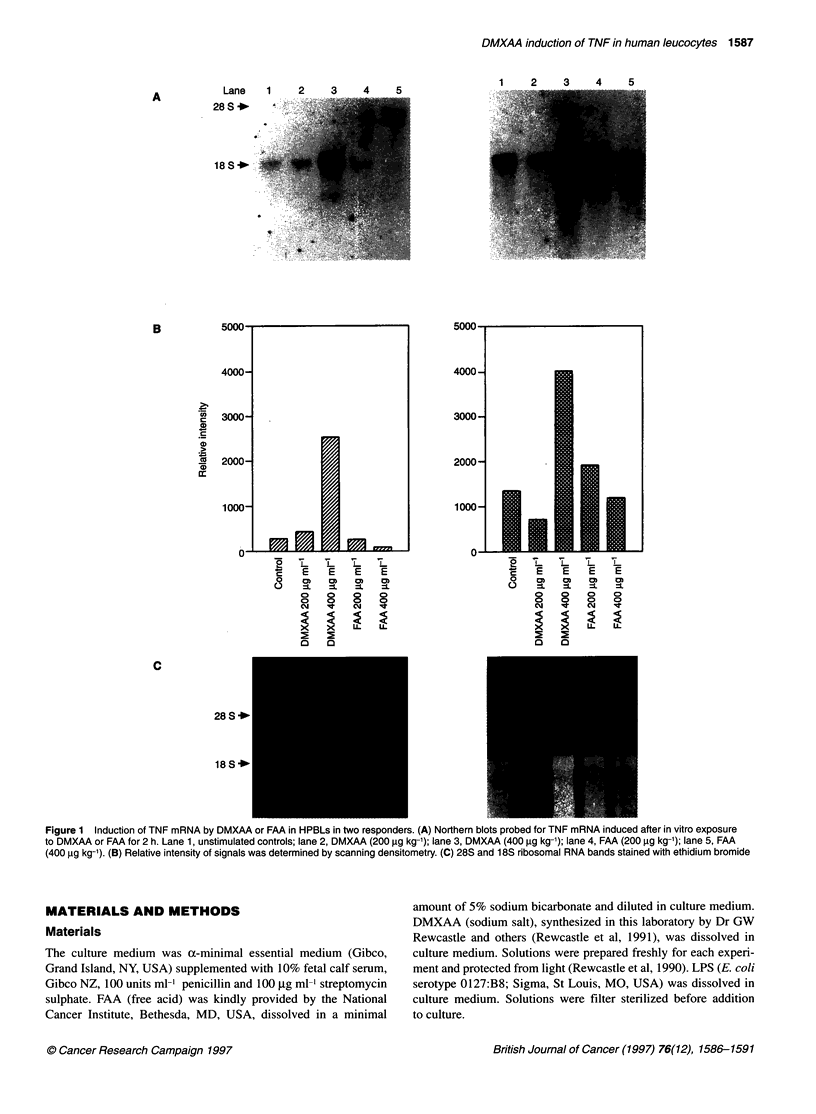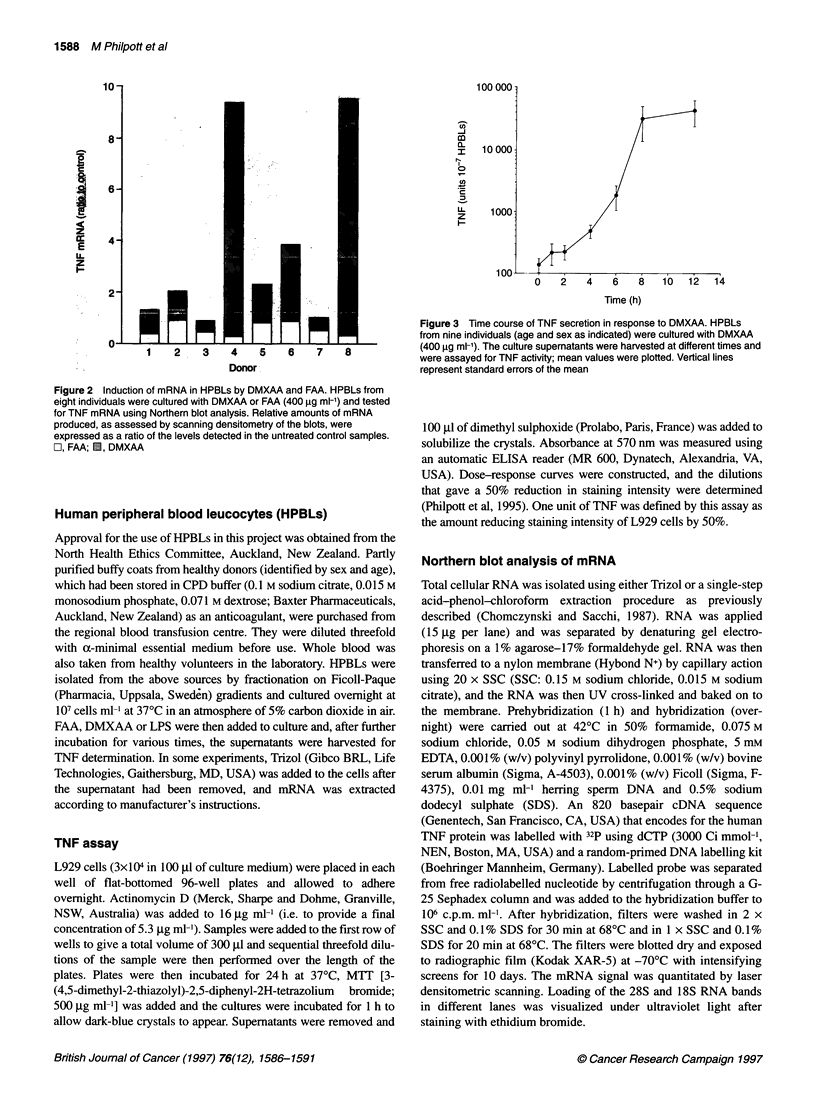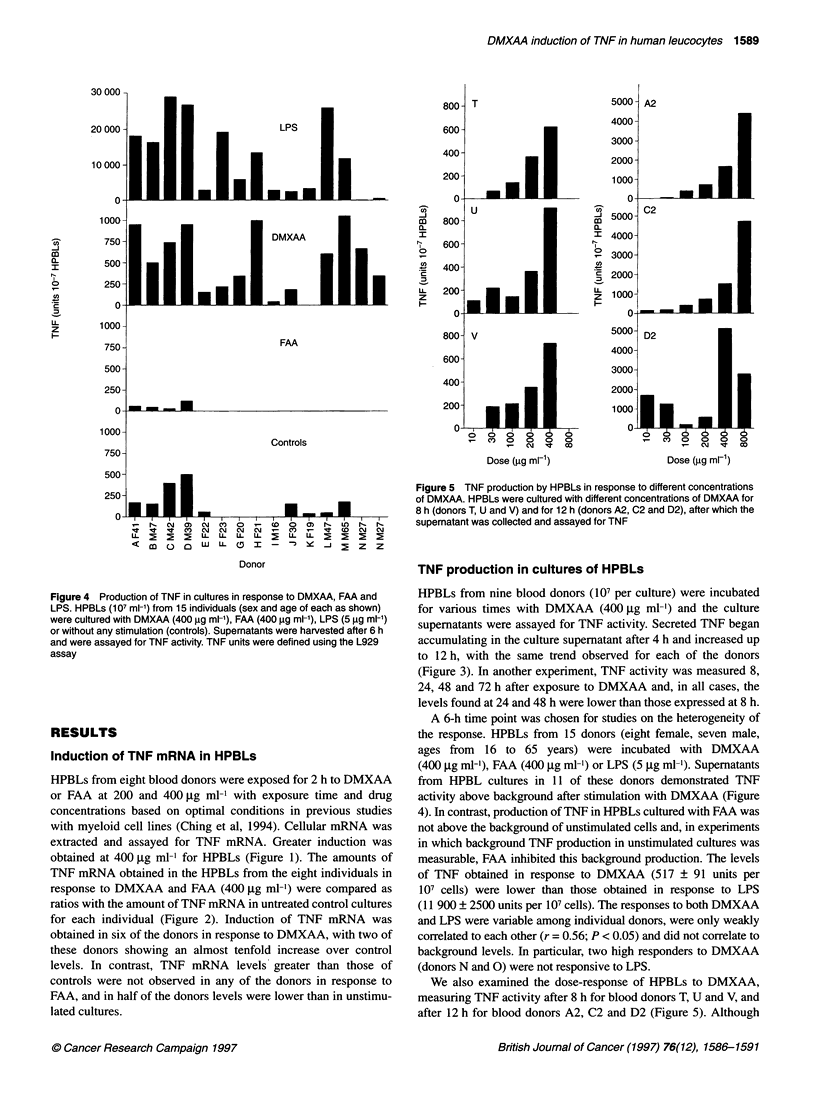Abstract
The investigative anti-tumour agent 5,6-dimethylxanthenonone-4-acetic acid (DMXAA, NSC 640488), developed in this laboratory as an improved analogue of flavone acetic acid (FAA, NSC 347512), is currently in clinical trial. The ability of DMXAA to up-regulate tumour necrosis factor (TNF) mRNA and protein synthesis in cultured human peripheral blood leucocytes (HPBLs) has been investigated and compared with that of flavone acetic acid (FAA) and of bacterial lipopolysaccharide (LPS). Human peripheral blood leucocytes were isolated from buffy coats obtained from a blood transfusion centre and also from blood samples from laboratory volunteers. At a concentration of 400 microg ml(-1) and an incubation time of 2 h, DMXAA up-regulated mRNA synthesis in six of eight individuals tested, as measured by Northern blotting. The degree of up-regulation varied in different individuals from one to nine times that of control levels. In contrast, FAA caused no induction above that of control levels and in some cases suppressed expression relative to controls, extending previous data that DMXAA but not FAA up-regulates TNF mRNA in the human HL-60 tumour cell line. At the same concentration but with longer incubation times (6-12 h), DMXAA induced increases in TNF protein in 11 of 15 samples of HPBLs from buffy coats and also in 11 of 15 samples of HPBLs from volunteers, as measured by cytotoxicity assays with L929 cells. FAA caused no increase in TNF protein, while LPS induced TNF to approximately 20-fold higher levels than did DMXAA. Considerable heterogeneity of response was observed with both sources of HPBLs, and there was little or no correlation between the extent of TNF induction by DMXAA and LPS in individual samples. In vitro analysis of the response of human peripheral blood leucocytes to DMXAA may be a useful test in clinical trials of agents such as DMXAA.
Full text
PDF





Images in this article
Selected References
These references are in PubMed. This may not be the complete list of references from this article.
- Baguley B. C., Calveley S. B., Crowe K. K., Fray L. M., O'Rourke S. A., Smith G. P. Comparison of the effects of flavone acetic acid, fostriecin, homoharringtonine and tumour necrosis factor alpha on colon 38 tumours in mice. Eur J Cancer Clin Oncol. 1989 Feb;25(2):263–269. doi: 10.1016/0277-5379(89)90018-7. [DOI] [PubMed] [Google Scholar]
- Bendtzen K., Morling N., Fomsgaard A., Svenson M., Jakobsen B., Odum N., Svejgaard A. Association between HLA-DR2 and production of tumour necrosis factor alpha and interleukin 1 by mononuclear cells activated by lipopolysaccharide. Scand J Immunol. 1988 Nov;28(5):599–606. doi: 10.1111/j.1365-3083.1988.tb01492.x. [DOI] [PubMed] [Google Scholar]
- Carswell E. A., Old L. J., Kassel R. L., Green S., Fiore N., Williamson B. An endotoxin-induced serum factor that causes necrosis of tumors. Proc Natl Acad Sci U S A. 1975 Sep;72(9):3666–3670. doi: 10.1073/pnas.72.9.3666. [DOI] [PMC free article] [PubMed] [Google Scholar]
- Ching L. M., Baguley B. C. Induction of natural killer cell activity by the antitumour compound flavone acetic acid (NSC 347 512). Eur J Cancer Clin Oncol. 1987 Jul;23(7):1047–1050. doi: 10.1016/0277-5379(87)90357-9. [DOI] [PubMed] [Google Scholar]
- Ching L. M., Joseph W. R., Baguley B. C. Inhibition of antitumor effects of flavone acetic acid by cortisone. Anticancer Res. 1993 Jul-Aug;13(4):1139–1141. [PubMed] [Google Scholar]
- Ching L. M., Joseph W. R., Crosier K. E., Baguley B. C. Induction of tumor necrosis factor-alpha messenger RNA in human and murine cells by the flavone acetic acid analogue 5,6-dimethylxanthenone-4-acetic acid (NSC 640488). Cancer Res. 1994 Feb 15;54(4):870–872. [PubMed] [Google Scholar]
- Chomczynski P., Sacchi N. Single-step method of RNA isolation by acid guanidinium thiocyanate-phenol-chloroform extraction. Anal Biochem. 1987 Apr;162(1):156–159. doi: 10.1006/abio.1987.9999. [DOI] [PubMed] [Google Scholar]
- Drouet C., Shakhov A. N., Jongeneel C. V. Enhancers and transcription factors controlling the inducibility of the tumor necrosis factor-alpha promoter in primary macrophages. J Immunol. 1991 Sep 1;147(5):1694–1700. [PubMed] [Google Scholar]
- Finlay G. J., Smith G. P., Fray L. M., Baguley B. C. Effect of flavone acetic acid on Lewis lung carcinoma: evidence for an indirect effect. J Natl Cancer Inst. 1988 Apr 20;80(4):241–245. doi: 10.1093/jnci/80.4.241. [DOI] [PubMed] [Google Scholar]
- Futami H., Eader L. A., Komschlies K. L., Bull R., Gruys M. E., Ortaldo J. R., Young H. A., Wiltrout R. H. Flavone acetic acid directly induces expression of cytokine genes in mouse splenic leukocytes but not in human peripheral blood leukocytes. Cancer Res. 1991 Dec 15;51(24):6596–6602. [PubMed] [Google Scholar]
- Haziot A., Tsuberi B. Z., Goyert S. M. Neutrophil CD14: biochemical properties and role in the secretion of tumor necrosis factor-alpha in response to lipopolysaccharide. J Immunol. 1993 Jun 15;150(12):5556–5565. [PubMed] [Google Scholar]
- Jacob C. O., Fronek Z., Lewis G. D., Koo M., Hansen J. A., McDevitt H. O. Heritable major histocompatibility complex class II-associated differences in production of tumor necrosis factor alpha: relevance to genetic predisposition to systemic lupus erythematosus. Proc Natl Acad Sci U S A. 1990 Feb;87(3):1233–1237. doi: 10.1073/pnas.87.3.1233. [DOI] [PMC free article] [PubMed] [Google Scholar]
- Kerr D. J., Kaye S. B. Flavone acetic acid--preclinical and clinical activity. Eur J Cancer Clin Oncol. 1989 Sep;25(9):1271–1272. doi: 10.1016/0277-5379(89)90072-2. [DOI] [PubMed] [Google Scholar]
- Lee J. D., Kato K., Tobias P. S., Kirkland T. N., Ulevitch R. J. Transfection of CD14 into 70Z/3 cells dramatically enhances the sensitivity to complexes of lipopolysaccharide (LPS) and LPS binding protein. J Exp Med. 1992 Jun 1;175(6):1697–1705. doi: 10.1084/jem.175.6.1697. [DOI] [PMC free article] [PubMed] [Google Scholar]
- Mahadevan V., Malik S. T., Meager A., Fiers W., Lewis G. P., Hart I. R. Role of tumor necrosis factor in flavone acetic acid-induced tumor vasculature shutdown. Cancer Res. 1990 Sep 1;50(17):5537–5542. [PubMed] [Google Scholar]
- McKeage M. J., Kestell P., Denny W. A., Baguley B. C. Plasma pharmacokinetics of the antitumour agents 5,6-dimethylxanthenone-4-acetic acid, xanthenone-4-acetic acid and flavone-8-acetic acid in mice. Cancer Chemother Pharmacol. 1991;28(6):409–413. doi: 10.1007/BF00685815. [DOI] [PubMed] [Google Scholar]
- McManus R., Wilson A. G., Mansfield J., Weir D. G., Duff G. W., Kelleher D. TNF2, a polymorphism of the tumour necrosis-alpha gene promoter, is a component of the celiac disease major histocompatibility complex haplotype. Eur J Immunol. 1996 Sep;26(9):2113–2118. doi: 10.1002/eji.1830260923. [DOI] [PubMed] [Google Scholar]
- Mølvig J., Baek L., Christensen P., Manogue K. R., Vlassara H., Platz P., Nielsen L. S., Svejgaard A., Nerup J. Endotoxin-stimulated human monocyte secretion of interleukin 1, tumour necrosis factor alpha, and prostaglandin E2 shows stable interindividual differences. Scand J Immunol. 1988 Jun;27(6):705–716. doi: 10.1111/j.1365-3083.1988.tb02404.x. [DOI] [PubMed] [Google Scholar]
- O'Dwyer P. J., Shoemaker D., Zaharko D. S., Grieshaber C., Plowman J., Corbett T., Valeriote F., King S. A., Cradock J., Hoth D. F. Flavone acetic acid (LM 975, NSC 347512). A novel antitumor agent. Cancer Chemother Pharmacol. 1987;19(1):6–10. doi: 10.1007/BF00296246. [DOI] [PubMed] [Google Scholar]
- Perera P. Y., Barber S. A., Ching L. M., Vogel S. N. Activation of LPS-inducible genes by the antitumor agent 5,6-dimethylxanthenone-4-acetic acid in primary murine macrophages. Dissection of signaling pathways leading to gene induction and tyrosine phosphorylation. J Immunol. 1994 Nov 15;153(10):4684–4693. [PubMed] [Google Scholar]
- Philpott M., Baguley B. C., Ching L. M. Induction of tumour necrosis factor-alpha by single and repeated doses of the antitumour agent 5,6-dimethylxanthenone-4-acetic acid. Cancer Chemother Pharmacol. 1995;36(2):143–148. doi: 10.1007/BF00689199. [DOI] [PubMed] [Google Scholar]
- Plowman J., Narayanan V. L., Dykes D., Szarvasi E., Briet P., Yoder O. C., Paull K. D. Flavone acetic acid: a novel agent with preclinical antitumor activity against colon adenocarcinoma 38 in mice. Cancer Treat Rep. 1986 May;70(5):631–635. [PubMed] [Google Scholar]
- Pratesi G., Rodolfo M., Rovetta G., Parmiani G. Role of T cells and tumour necrosis factor in antitumour activity and toxicity of flavone acetic acid. Eur J Cancer. 1990;26(10):1079–1083. doi: 10.1016/0277-5379(90)90056-y. [DOI] [PubMed] [Google Scholar]
- Rewcastle G. W., Atwell G. J., Li Z. A., Baguley B. C., Denny W. A. Potential antitumor agents. 61. Structure-activity relationships for in vivo colon 38 activity among disubstituted 9-oxo-9H-xanthene-4-acetic acids. J Med Chem. 1991 Jan;34(1):217–222. doi: 10.1021/jm00105a034. [DOI] [PubMed] [Google Scholar]
- Rewcastle G. W., Kestell P., Baguley B. C., Denny W. A. Light-induced breakdown of flavone acetic acid and xanthenone analogues in solution. J Natl Cancer Inst. 1990 Mar 21;82(6):528–529. doi: 10.1093/jnci/82.6.528. [DOI] [PubMed] [Google Scholar]
- Spies T., Morton C. C., Nedospasov S. A., Fiers W., Pious D., Strominger J. L. Genes for the tumor necrosis factors alpha and beta are linked to the human major histocompatibility complex. Proc Natl Acad Sci U S A. 1986 Nov;83(22):8699–8702. doi: 10.1073/pnas.83.22.8699. [DOI] [PMC free article] [PubMed] [Google Scholar]



